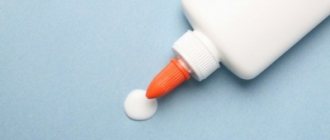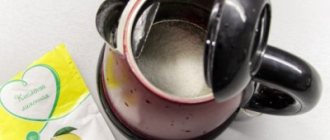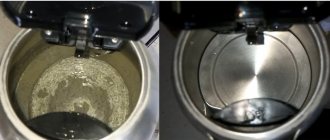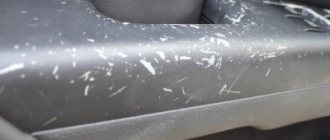Hard water harms not only human health, but also household appliances. Because of it, a thick layer of scale forms on the walls of the kettle.
The problem cannot be left unattended. Table vinegar helps to cope with plaque.
Read the article on how to properly descale a kettle with vinegar.
How to remove limescale at home?
To get rid of a thick layer of scale, you must follow the following procedure:
Fill a bowl with cold water.- Add table vinegar to it. For 1 liter you will need 100 ml of acid. If essence is used, then take 1 tablespoon per 1 liter.
- Place the kettle on the stove or plug it in.
- Bring the solution to a boil and leave for 3 hours to take effect.
- After the specified time, the softened scale must be cleaned off with the back of the sponge.
- Rinse the kettle several times to completely remove any remaining vinegar. For greater reliability, you can boil clean water in it and drain it.
If the layer of limescale is small, then the water does not need to be brought to a boil. In this case, proceed as follows:
- pour 1 liter of warm water into the kettle;
- add 100 ml of table vinegar to it;
- leave the composition overnight;
- In the morning, clean the inner walls with a soft brush and rinse several times with clean water.
Preventive cleaning is carried out in the same way.
How to descale a kettle with vinegar, video instructions:
What can you use to diversify the recipe?
A recipe based on acetic acid can be supplemented with other means. This will increase the effectiveness of the procedure:
Ascorbic acid .
For 2 liters of water you will need two tablespoons of essence and two tablespoons of acid, crushed into powder. The solution is boiled and left for 12 hours to have an effect. This is a very effective recipe, thanks to which you do not need to clean off the scale. Salt deposits will dissolve on their own in the water. All that remains is to rinse the kettle thoroughly.- Baking soda . By reacting with vinegar, it enhances its effect. Read more here.
- Salt. For 1 liter of water take one tablespoon of table salt.
Is it possible to prevent scale formation?
Even when buying “Lux” water, you cannot completely forget about scale in the kettle.
To reduce this problem, the following conditions are recommended:
- Use filters when water comes from the central system. Manufacturers offer different installations. They are small in size and can be placed under the sink. Replacing inexpensive cassettes will not hit the family budget. A filter installed directly on the tap is economical and effective.
- Drain off the remaining boiled water. Otherwise, salts will continue to be deposited and the plaque layer will increase.
- Use fresh water each time you boil.
- Keep a separate soft sponge in the kitchen for daily cleaning of the kettle. Do this procedure at night.
- Change the removable block in the filter jug in a timely manner.
How often should cleaning be done?
The kettle should be cleaned at least once a month. If tap water is hard, then the procedure is carried out once every 2 weeks. Thanks to this frequency, you can keep the device clean, which will have a positive effect on its service life.
There are regions where tap water is soft. In this case, cleaning the kettle with vinegar is carried out once a month.
Even if you need to deal with scale more frequently, there is no need to worry about it. Vinegar does not harm the walls of the device and does not reduce its service life.
Precautionary measures
A product containing acid requires careful storage and compliance with safety precautions when working. Basic Rules:
- bottles with essence or table composition are stored in a place inaccessible to children and pets, always tightly sealed with stoppers and with a label;
- when working with cleaning solutions, use protective gloves;
- do not bend over a kettle boiling on the stove, as it is easy to get a burn to the mucous membranes from the caustic fumes;
- To prepare the solution, fill the container only 2/3 with water. When boiling, in this case, the liquid will not splash out of the spout or hole under the lid.
Be sure to follow the recipe proportions. The rule “you can’t spoil porridge with oil” does not apply here - the solution is prepared strictly according to the indicated dosages.
Alternative options
In addition to vinegar, you can deal with scale in the kettle using other available means. In this regard, substances such as:
- soda,
- lemon acid,
- carbonated drinks.
If you don’t want to use traditional recipes, you can purchase specialized formulations that are sold in stores in departments with household chemicals or in online markets.
How to cleanse with folk remedies?
Soda. For a 3 liter kettle you will need 3 tablespoons of soda. The container is filled 2/3 full, the solution is brought to a boil and left for 5 hours. After this, rub the limescale deposits with a soft brush and rinse the container with warm water.- Lemon acid .
It acts like table vinegar, but is less aggressive than essence. To remove limescale from a three-liter kettle, you will need from 30 to 60 g of acid. The thicker the layer, the more powder is used. Fill the kettle halfway, add the required amount of citric acid and bring the solution to a boil. When the composition has cooled, it is drained and the loose scale is cleaned off with a brush. - Sparkling water . To remove scale, you can use Coca-Cola, Fanta or Sprite. If the kettle is plastic, then preference is given to colorless drinks. Carbonated water is poured into the container, filling it 2/3 full. Bring the solution to a boil, turn off the gas, wait until the liquid cools and pour it into the sink. As a rule, there is no need to use a brush after treating with sparkling water. The substances contained in the drink dissolve all limescale without a trace.
How to remove deposits with household chemicals?
Stores sell specialized descaling compounds. The most effective means:
- Top House : descaling agent for teapots and coffee makers. Pour 1 liter of clean water into the device, bring it to a boil and turn off the gas. 60 ml of solution is added to boiling water and left for 30 minutes to act. After the specified time, all that remains is to drain the dirty water and rinse the container several times. The cost of 500 ml of solution is 250 rubles.
- Topper anti-scale tablets for teapots and coffee makers. To remove salt deposits, pour water into the device, add one tablet and bring the liquid to a boil. When it cools down, it is drained and the kettle is thoroughly washed. The cost of two tablets is 90 rubles.
- Melitta Anti calc descaler for teapots. To remove salt deposits, use 100 ml of solution per 1 liter of water. The liquid is poured into the kettle and brought to a boil; when it cools, it is drained. The cost of 250 ml of solution is 365 rubles.
How to remove vinegar smell
One of the most effective products for descaling dishes has one problem - a pungent odor that lingers in the kettle for a long time. To eliminate the specific aroma, it is recommended to boil the dishes with salt or soda after cleaning.
Here's a life hack: pour water, add your choice of a spoon (tablespoon) of salt or the same amount of baking soda. Boil and, after standing for 10-15 minutes, drain the solution.
A good result after cleaning is obtained by boiling water with a pinch of citric acid (can be replaced with a slice of natural citrus).
Features for different types of kettles
Metal, glass and plastic teapots are not afraid of contact with vinegar. However, there are certain cleaning rules that should not be violated:
Essence cannot be used to remove lime deposits from a plastic kettle. It contains too high a concentration of acid, so its incorrect use can cause damage to the device.- To remove scale from glass teapots, do not use hard metal brushes. They leave behind many small scratches, on which calcium salts will subsequently settle.
- Stainless steel teapots are not afraid of contact with acids; their inner surface can be cleaned with a stiff brush, but in no case should you use sharp devices, such as a knife.
- To clean electrical appliances, it is unacceptable to use a combination of baking soda and vinegar. This recipe is only suitable for descaling regular kettles.
- It is not recommended to treat enamel teapots with vinegar, as they are susceptible to acid attack. If you have such a device in your home, it is better to use a colorless carbonated drink.
Advantages and disadvantages
The main “advantage” of vinegar is its availability and low cost. Manufacturers of household chemicals offer many different compositions for cleaning kitchen utensils from limescale, but almost all of them are expensive, and some are also ineffective. Vinegar is sold in any grocery store, and solutions of different concentrations are available to customers.
Advantages and disadvantages
Safety.
Efficiency.
Easy to use.
Economical.
When solutions are heated, caustic vapors are formed. They are safe for human health, but it is better to work in a ventilated area.
Not suitable for all models.
Heavy scale will need to be removed step by step and only with boiling.
The main thing is not to bring the dishes to a terrible state and the formation of old layers of deposits, when radical cleaning is required.
Helpful information
When descaling, you should adhere to the following recommendations:
- when descaling with vinegar, the windows must be kept open and there must be good ventilation in the room, as the acid emits a pungent odor when it evaporates;
- to remove a small layer of scale, use table vinegar with a concentration of 9%;
- to combat old plaque, it is better to resort to the help of essence;
- When the kettle boils, you cannot lean over it, because... fumes can cause respiratory burns.
To ensure that as little scale as possible accumulates on the inner surface of the device, it is not recommended to leave water in it - the remains must be drained, this will prevent the appearance of a thick layer of plaque on the bottom.
Useful and important information about descaling methods can be found here.
Why is it dangerous?
Regular tap water contains many harmful salts (magnesium, calcium). They begin to settle to the bottom of the device. When boiling, the structure of the liquid changes, which causes plaque to appear.
When a few particles of such plaque enter the human body, it is not dangerous. However, if such scale settles constantly, it can cause great harm to it.
Salts begin to dissolve in the stomach. They reach all vital organs. Scientists call this phenomenon reabsorption. As a result, excess salts begin to clog blood vessels and block the functioning of joints. Sometimes a large amount of salts leads to the appearance of small stones in the kidneys.
If a white coating appears in the kettle, you need to get rid of it immediately to maintain health. There are many ways to destroy scale. One of the most effective options is to descale the kettle using regular vinegar.











